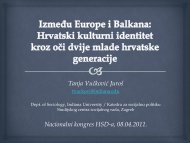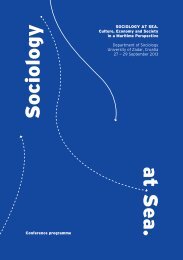rujan 2011. - Hrvatsko sociološko društvo
rujan 2011. - Hrvatsko sociološko društvo
rujan 2011. - Hrvatsko sociološko društvo
You also want an ePaper? Increase the reach of your titles
YUMPU automatically turns print PDFs into web optimized ePapers that Google loves.
‣ Mežnarić, S. Migration in Croatia: What to Expect?u: Krasteva, A., Kasabova, A., Karabinova. D. (2010)<br />
Migrations from and to Southeastern Europe. Ravenna: Longo Editore Ravenna, s. 35-46 (knjiga izašla u<br />
siječnju 2011)<br />
Sažetak: Within the context of European regulation of migration and policies expected, what kind of strategies and<br />
goals Croatia has to design in order to mitigate the opening up of its (Eastern) borders. Demography and labor<br />
market policies, flexibility, were taken into account. Compared to migration policies of: Ireland, Australia, Slovenia.<br />
‣ Štulhofer, A., Buško, V., Brouillard, P. (2011). “The New Sexual Satisfaction Scale and its short form“ . In<br />
Fisher, T. D., Davis, C. M., Yarber, W. L., & Davis, S. L. /Eds./ Handbook of sexuality-related measures<br />
(3rd edition). New York: Routledge, pp. 530-532.<br />
Sažetak: Sexual satisfaction scale.<br />
‣ Štulhofer, A., Landripet, I. (2011). “Sexual Scripts Overlap Scale — short version“. In Fisher, T. D., Davis,<br />
C. M., Yarber, W. L., & Davis, S. L. /Eds./ Handbook of sexuality-related measures (3rd edition). New<br />
York: Routledge, pp. 604-605.<br />
Sažetak: Sexual scripts overlap scale.<br />
‣ Valenta, M., Mesić, M., Strabac, Z. Bosnian Croats in Croatia: 'Etnically Privileged Migrant, 'Culturaly<br />
Distant Co-ethnics' or 'Croats as any Other Croats'?' The Bosnian Diaspora, Integration in Transnational<br />
Communities / Valenta, Marko and Sabrina P. Ramet (ur.).<br />
Surrey : ASHGATE, <strong>2011.</strong> Str. 281-300.<br />
Sažetak: Based on previous studies on Bosnian refugees around the world, the authors assume, that unlike other<br />
migrants in Croatia, Bosnian Croats in Croatia may be seen as 'co-ethnic migrants' or 'ethnically privileged<br />
migrants'. However, it is also assumed that Bosnian Croats in Croatia are defined in two diametrically different ways<br />
- as lw status, culturally distant co-ethnics and as Croats as any other Croats, which has resulted in a different<br />
positioning toward the mainstream society.<br />
‣ Zrinščak, S. (2011) Local immigrant communities,welfare and culture: an integration / segregation<br />
dilemma. In: E. Carmel, A. Cerami and T. Papadopoulos (eds.) Migration and Welfare in the New Europe.<br />
Social Protection and the Challenges of Integration. University of Bristol, UK: The Policy Press, pp. 197-<br />
212.<br />
Sažetak: The chapter focuses on the role of migrant communities, ethnic as well as religious, while arguing that the<br />
social position of immigrants, and particularly their access to welfare rights, can not be adequately analyzed if not<br />
taking into account the general social positions and strategies of migrant ethnic and religious organizations. Based<br />
on the empirical research in twelve European countries the chapter investigates in more details the importance of<br />
families and migrant communities for the everyday life of immigrants, and the work of welfare networks that these<br />
communities organize for satisfying needs of their members: welfare, educational, religious, etc. It particularly<br />
stresses the importance of the concept of identities, the importance of religion, language, and families (nuclear and<br />
extended) for immigrants, but it also reflects the social debates and conflicts that are visible in many European<br />
societies nowadays. The chapter also questions the adequacy of the welfare state approach in researching the access<br />
of immigrant to different social rights.



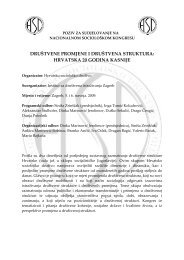

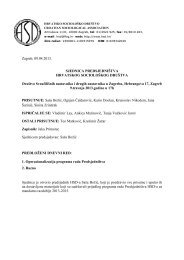
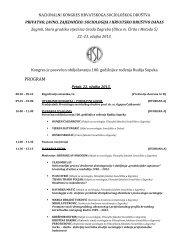
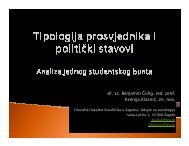
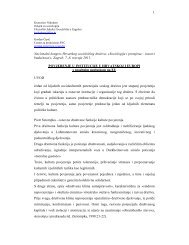
![PROGRAM SKUPA [pdf] - Hrvatsko sociološko društvo](https://img.yumpu.com/38770359/1/184x260/program-skupa-pdf-hrvatsko-socioloako-druatvo.jpg?quality=85)
